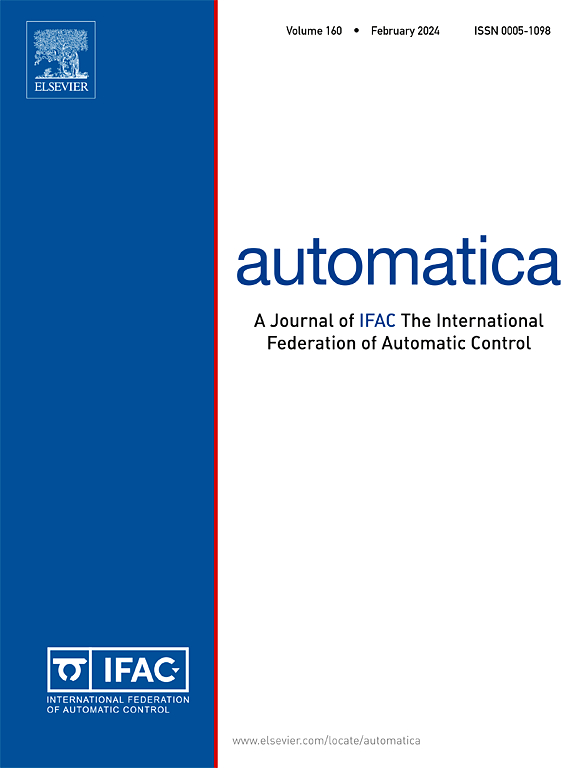使用可达性分析进行安全的时间关键验证的固定时间学习
IF 5.9
2区 计算机科学
Q1 AUTOMATION & CONTROL SYSTEMS
引用次数: 0
摘要
在本文中,我们使用可达性分析解决了一个安全的时间关键控制问题,并设计了一个基于强化学习的机制,用于在线学习和固定时间学习安全时间关键控制问题的解决方案。安全是通过确定一组状态来保证的,这些状态存在一个允许的控制律,产生一个系统轨迹,在用户规定的时刻不会达到一组禁止状态。具体而言,我们将安全时临界问题转化为Mayer最优反馈控制问题,其解满足Hamilton-Jacobi-Bellman (HJB)方程,并表征了安全状态集。由于HJB方程通常难以求解,我们开发了一种基于在线仅限临界强化学习的算法,用于在固定时间内同时学习HJB方程的解和安全集的解。特别是,我们引入了一个基于非lipschitz经验重放的学习律,利用记录的和当前的数据来更新评价权重,以学习价值函数和安全集。动力学的非lipschitz性质导致固定时间收敛,而基于经验重放的方法在记录数据集足够丰富的情况下消除了满足激励条件持久性的需要。仿真结果验证了该方法解决固定翼无人机避碰问题的有效性。本文章由计算机程序翻译,如有差异,请以英文原文为准。
Fixed-time learning for safe time-critical verification using reachability analysis
In this paper, we address a safe time-critical control problem using reachability analysis and design a reinforcement learning-based mechanism for learning online and in fixed-time the solution to the safe time-critical control problem. Safety is ensured by determining a set of states for which there exists an admissible control law generating a system trajectory that does not reach a set of forbidden states at a user-prescribed time instant. Specifically, we cast our safe time-critical problem as a Mayer optimal feedback control problem whose solution satisfies the Hamilton–Jacobi–Bellman (HJB) equation and characterizes the set of safe states. Since the HJB equation is generally difficult to solve, we develop an online critic-only reinforcement learning-based algorithm for simultaneously learning the solution to the HJB equation and the safe set in a fixed time. In particular, we introduce a non-Lipschitz experience replay-based learning law utilizing recorded and current data for updating the critic weights to learn the value function and the safe set. The non-Lipschitz property of the dynamics gives rise to fixed-time convergence, whereas the experience replay-based approach eliminates the need to satisfy the persistence of excitation condition provided that a recorded data set is sufficiently rich. Simulation results illustrate the efficacy of the proposed approach to the problem of fixed-wing unmanned aerial vehicle collision avoidance.
求助全文
通过发布文献求助,成功后即可免费获取论文全文。
去求助
来源期刊

Automatica
工程技术-工程:电子与电气
CiteScore
10.70
自引率
7.80%
发文量
617
审稿时长
5 months
期刊介绍:
Automatica is a leading archival publication in the field of systems and control. The field encompasses today a broad set of areas and topics, and is thriving not only within itself but also in terms of its impact on other fields, such as communications, computers, biology, energy and economics. Since its inception in 1963, Automatica has kept abreast with the evolution of the field over the years, and has emerged as a leading publication driving the trends in the field.
After being founded in 1963, Automatica became a journal of the International Federation of Automatic Control (IFAC) in 1969. It features a characteristic blend of theoretical and applied papers of archival, lasting value, reporting cutting edge research results by authors across the globe. It features articles in distinct categories, including regular, brief and survey papers, technical communiqués, correspondence items, as well as reviews on published books of interest to the readership. It occasionally publishes special issues on emerging new topics or established mature topics of interest to a broad audience.
Automatica solicits original high-quality contributions in all the categories listed above, and in all areas of systems and control interpreted in a broad sense and evolving constantly. They may be submitted directly to a subject editor or to the Editor-in-Chief if not sure about the subject area. Editorial procedures in place assure careful, fair, and prompt handling of all submitted articles. Accepted papers appear in the journal in the shortest time feasible given production time constraints.
 求助内容:
求助内容: 应助结果提醒方式:
应助结果提醒方式:


